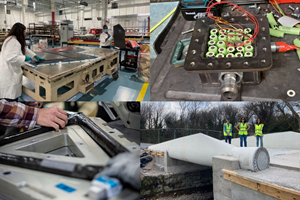Is it time for carbon fiber manufacturers to cooperate?
In anticipation of CompositesWorld's 2015 iteration of its annual Carbon Fiber conference, set for December, CW editor-in-chief Jeff Sloan looks ahead to the future as he recalls some tough questions about carbon fiber standardization posed by last year's keynote speaker.
I took my second son to college in August. In September, I turned 48. My wife and I have one more child to usher through high school and into the world. For the first time in 15 years, I am starting to imagine life without a minivan. These milestones have got me thinking more about the future — immediate and long term.
The immediate future takes me to December, when we here at CW will host our annual Carbon Fiber conference, Dec. 8-10, featuring a keynote presentation from Perry Moore, director of 777X Wing Operations at Boeing Commercial Airplanes. Moore will discuss development of the carbon fiber composite wings for the 777X. I’m reminded that one year ago, at Carbon Fiber 2014, John Byrne, Boeing’s VP aircraft materials and structures, admonished the carbon fiber supply chain for its relative immaturity — especially compared to aluminum and titanium. In particular, Byrne said he does not like the fact that carbon fiber is not “standardized,” which means Boeing must sole-source the material from Toray.
My gut reaction was to dismiss Byrne’s complaint as that of a man who, being in charge of purchasing as he is, must always be in search of lower-cost, widely available materials. However, having turned 48, being that much older and wiser, and suddenly contemplative about the future, I’m having second thoughts.
The 777X represents the last major aerospace program into which the composites industry can pour its products and services. For the next 10-15 years, application of composites in new aircraft likely will be relatively small — rotorcraft, business jets and maybe a commuter aircraft or two. It’s not until we approach 2030 that redesigns of the 737 and A320 might represent the next big program opportunities for composites use.
On top of this, the increased use of carbon fiber in automotive is starting to stratify the carbon fiber manufacturing supply chain, with high-strength, high-modulus aerospace-grade fiber on one level, and intermediate-strength, intermediate-modulus, industrial-grade fiber on another level. As we’ve reported, this is stimulating much research into new precursors and new technologies designed to bring down the cost of fiber production. Put these factors together, and between now and 2030 several things are likely to occur: carbon fiber manufacturing (all types) will become cheaper, more efficient and easier; there will be more carbon fiber manufacturers in the world; material qualification time will be shortened to a number of years less than the current 10; and thermoplastic composites will become a serious and regular contender for use in commercial aerospace structures.
If I’m right, then carbon fiber manufacturers — especially for aerospace applications — almost certainly cannot bank on winning sole-source supply contracts in 2030 like they do today. The materials environment will almost certainly will be too competitive, and carbon fiber likely will be more commodity-like than it is today.
If this is the case, then an effort must be made to start standardizing fibers the same way legacy materials are standardized. That is, we must establish a set of fiber performance standards for a given fiber grade — let’s call it CFAERO or CFAUTO. Carbon fiber manufacturers then would have to produce fiber to the standards associated with the particular grade if they want to put the CFAERO or CFAUTO label on it. Then, companies like Boeing or Airbus, or whoever is around in 2030, could “shop” for CFAERO from several suppliers on the market.
I will admit that some of my suppositions might be flawed — I don’t make carbon fiber and lack the insight that a manufacturer has. But it’s not hard — especially give the rapid pace of change in carbon fiber manufacturing technology — to imagine a world in which carbon fiber is more easily and cheaply produced. However, this would require a level of coordination and cooperation that is unprecedented in the composites industry.
That said, such cooperation has benefited other industries, and it can be done here. And in the end, the market itself might force manufacturers into such cooperation, or otherwise risk sliding into irrelevance.
Stay tuned for my 50th birthday hypotheses.
Related Content
CAMX 2022: 10 reasons to attend
Looking for a good reason to attend CAMX 2022? Look no further.
Read MoreWe're going to need a lot of propeller blades
As advanced air mobility expands and annual shipsets get into the thousands, the demand for composite propeller blades is expected to skyrocket. What are the implications for the composites supply chain?
Read MoreAs 2023 begins, a look back at trending CW topics in 2022
With 2022 now behind us, CW’s editor-in-chief Jeff Sloan takes a look at the CW stories last year that received the most reader attention.
Read MoreReading the Boeing tea leaves
Boeing CEO David Calhoun says not to expect a new aircraft before 2035. What are aerocomposites fabricators supposed to make of that?
Read MoreRead Next
Composites end markets: Energy (2024)
Composites are used widely in oil/gas, wind and other renewable energy applications. Despite market challenges, growth potential and innovation for composites continue.
Read MoreCW’s 2024 Top Shops survey offers new approach to benchmarking
Respondents that complete the survey by April 30, 2024, have the chance to be recognized as an honoree.
Read MoreFrom the CW Archives: The tale of the thermoplastic cryotank
In 2006, guest columnist Bob Hartunian related the story of his efforts two decades prior, while at McDonnell Douglas, to develop a thermoplastic composite crytank for hydrogen storage. He learned a lot of lessons.
Read More


























